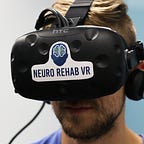ADVANCED INTEGRATION OF VIRTUAL REALITY INTO PHYSICAL THERAPY
In the previous blog post, we covered general integration of virtual reality into physical therapy, so let’s dig deeper today! One key thing I want to bring back up is just how simple the set up is for virtual reality. Most of Neuro Rehab VR’s exercises only require the VR headset and 2 controllers donned on the patient. Simple enough, right? For more complicated cases where integration seems more daunting, I have good news for you; applying VR continues to remain simple.
In fact, one might find that virtual reality compliments many functional positions and exercises you would normally perform within your sessions. From complex body weight support ambulation activities, to gait training, to sustaining balance in tall/half kneeling positions, and more; VR can be utilized. Below, I have compiled my experience integrating this wonderful immersive tool into patient goals from low functioning to high functioning; let’s get into it!
First on our agenda is the standing frame. It comes in multiple forms and is even included in some electric wheelchairs. Standing frames offer a huge potential for VR utilization! Once the patient is safely up in their standing frame, knees aren’t hyper extended etc., apply the headset ensuring proper fit, and apply remotes to bilateral upper extremities with proper securing devices like active hands or ace bandages if needed. After verbal affirmation from the patient, select the Neuro Rehab VR exercise designed for their use case.
THE STANDING FRAME
Neuro Rehab VR offers multiple therapeutic exercises that can be performed within a standing frame, but I am going to focus on Retail Therapy and Fowl Play. For Retail Therapy, despite being secured into a standing frame, focus can be put on reaching and grasping objects anterolateral with bilateral upper extremities i.e. for c5 and higher spinal cord injury patients. Doing this activity turns a static experience into a goal oriented weight bearing activity with bilateral upper-extremity and trunk usage. The same goes for Fowl Play, except no remotes are needed in the hand and all the focus is on the trunk due to having to dodge balls coming at you. Standing frames perfectly compliment the use of virtual reality. Lets move on to body weight support ambulation systems!
BODY WEIGHT SUPPORT SYSTEMS
At first glance, body weight support ambulation systems had me scratching my head on how virtual reality could be properly integrated without taking away from the gait training aspects of these systems. With a VR headset donned, the patient is no longer paying attention to the individual intricate details of their gait, but rather focusing on the task presented in front of them within the virtual reality environment. Because of this, VR needs to be integrated at a specific time to ensure it does not inhibit the patient from working on improving gait mechanics. For instance, I have found focusing on fine tuned gait mechanics during the first portion of BWS (body weight supported) ambulation activities, then transition to focus on hammering out distance and carryover of practiced mechanics within the VR headset. When utilizing the Loko Sprint application from Neuro Rehab VR, traveling great distances is gamified by placing coins in front of the patient with slight deviations in positioning. Better yet, if their speed increases on the BWS ambulation system, so does their visible speed within the headset in real time without any modifications to settings required. Alright, onto higher functioning integration, while working on walking and static balance using VR and a BWS systems.
VR WITH THE HIGH FUNCTIONING PATIENT
Working to improve balance with higher functioning patients within the VR space has been one of the most rewarding experiences of my career. Don’t get me wrong, working with VR in general has been incredibly rewarding no matter the level of function. By being able to challenge the patients balance by coupling balance disks, blue foam pads, bosu balls, and more, provides a level of challenge and engagement unlike anything I have seen. For example, virtual reality in a tall kneeling position adds an extra layer of challenge not found elsewhere. Due to their exercise and instruction predominantly being within the headset, the therapist gets to solely focus on the patient’s position and movement without environmental distractions, or the utilization of a technician. Lets say we have a patient requiring glute/trunk strength, so we couple tall kneeling with Fowl Play, challenging the patient to not only stabilize in that position, but also dodge balls coming at them. When working on standing balance, once a patient is stabilized on a bosu ball, blue foam pad, incline wedge, etc., don the headset on your patient and let the “magic” begin!
To reiterate, utilizing VR can seem daunting when first dipping your toes in these unfamiliar waters of new technology, but I hope your worries are lessened and your excitement for virtual reality is growing. We are just scratching the surface of the therapeutic benefits of this technological modality. Be sure to reach out for more information regarding Neuro Rehab VR’s XR Therapy System for purchase or comment your questions that can be answered in future blog posts!
